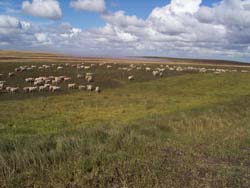
The Falkland Islands are truly a special place, where "nature is still in charge". It is easy to imagine that most people are familiar with hearing about a location being described as "unique", but at the risk of sounding a little boastful, the Falkland Islands truly are! Certainly not everyone's dream of heaven, but for those who enjoy the simple and pure things in life, where the windswept landscape, changeable weather patterns and beautiful wildlife are appreciated, it is a hard place to beat.
Farming at 52° South of the Equator will never be easy. Unseasonable snow, hail, very short pasture growing season and strong winds all have to be contended with. It is pushing farming towards the limit. However, for the 88, predominantly family farms in the Falkland Islands, instead of complaining too much about the things that cannot be changed, the task has always been to simply get on and do everything that can be done, as well as possible!
The Falkland Islands have a very long sheep farming history. For almost 150 years sheep have been grazed on the wide-open native white grass camps and rich coastal valleys and "greens". Stocking rates are quite low compared to many other places, with approximately one sheep being run on two hectares of land.
The vast majority of sheep in the Falklands are of Corriedale ancestry, however over the last 10 to 12 years there has been a dramatic shift to the finer Polwarth types.
Economic survival has driven this breed shift, and it is fair to state that the change has been made reluctantly by some farmers who have watched their hardy Corriedale sheep perform solidly year after year through many difficult winters as well as the good years. It is interesting to note that the performance of the predominately Polwarth type sheep are now matching the performance of the Corriedale animals in terms of reproductive rates and wool cuts per head while also being several microns finer!
The Falkland Islands is obviously not a "major player" in the worldwide wool industry. It's small size and relative isolation will always be important "trade issues", however, what it does have in its favour is an environment that allows the production of wool of exceptional purity and freedom from chemical residues. The Islands have a complete absence of sheep lice and sheep ked (allows animals freedom from dipping and jetting) plus very few internal parasites (not much of a need to drench) and an overall disease status that would be envied by most countries if they knew about it.
The environment, while harsh at times for both people as well as livestock, also provides natural protection from the range of bacteria and organisms that cause wool damage, wool discolouration and predisposes animals to fly strike. As a result wool produced from Falkland Islands sheep has outstanding whiteness and softness.
Sheep farming in the Islands has traditionally been carried out for wool production. The absence of an export sheep meat outlet until recently (EU approved abattoir commissioned in 2003) meant that a balanced flock was the "norm" on most farms. The priority was to have enough breeding ewes to sustain sheep numbers while maximising wool production. As a result large numbers of wethers were kept on most farms.
The typical Falkland Islands farm might run something like 6,000 sheep and a relatively small number of cattle. About 2,000 of the sheep would be breeding ewes, 2,000 young "followers" and the remaining 2,000 mature wethers. Farm average fibre diameter would be about 26 micron and sheep would average approximately 3.7kg of greasy wool of yield 68/69%. Vegetable matter levels in fleece wool lines are almost always less than 0.5% and indeed even non-fleece lines generally have VM levels of less than 1%.
Wool preparation and wool classing is taken very seriously: World-Best practice standards are adopted with a mix of professional wool classers and "owner classers" controlling the operation.
Flocks of animals are usually shorn on an age and breeding status basis. Great attention is placed on removal of stain, pigmented fibre and non-typical wool.
There are a number of economic challenges facing farmers in the Falkland Islands, just as they are everywhere else in the world. In addition to challenges however, there are a number of major opportunities as well. As an example the development of an EU approved export outlet for sheep meat now exists. As a result farmers are aggressively reviewing their flock structure (with a view to increasing the proportion of breeding ewes) in addition to the basic option of breed choice.
Farmers have invested considerably over the last couple of years in sheep genetic material from South Africa, New Zealand and Australia. Farmers are trialling improved dual-purpose breeds that offer the potential to considerably reduce fibre diameter while enhancing sheep meat characteristics.
Results to date from these trials have been very encouraging, particularly concerning the Dohne Merino and South African Mutton Merino breeds.
